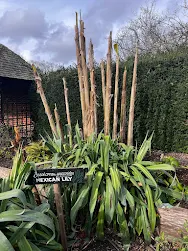Herne Hill's name is a bit mysterious - "A Dictionary of London Place Names" suggests it's derived from "le Herne", or "corner of land", or perhaps it's related to a family that lived here. It used to be known as "Island Green", presumably a reference to the aforementioned Brockwell Park. Yet as the railways arrived in the 19th century, Herne Hill was adopted as the area's name, and as it began to expand, the name stuck. It's also one of many nearby "hills" in the area - Tulse, Denmark and Streatham, for example - though Herne Hill's topography isn't all that different to the surroundings. But enough about the etymology.
Brockwell Park
I entered the park through the entrance next to the lido, a listed building which originally opened back in 1937 and, except for four years in the early 1990s, has been open ever since. From there, it was largely a walk around the park before I exited by one of the main roads.
There were a few interesting places to point out. There are the ponds, for example, which aren't all that different from other ponds. Yet they're still quite large and it can be quite relaxing to watch the birds on a Sunday morning. It's also a prime place to try and photograph birds, as evidenced by my very brief blogpost a few weeks ago. And yes, I visited a while ago, but I doubt much has changed in the park since then.

And the rest of the park was pleasant, even if the grass was muddy and the weather quite mild. From a distance, you can see the Central London skyline, partly blocked out by brutalist estate blocks - in the other direction, a spire protrudes amongst the houses. If I had properly researched the park before I visited, I may have photographed the clock tower or Brockwell Hall, a grander house which used to be owned by glassmaker John Blades in the early 19th century, before he house and land around it (the first parts of the park) were acquired by the council in 1888. And if I visited the park nearly 200 years ago, I'd have seen the River Effra flowing through the park, before it was covered up and converted into being used to transport sewage. The only proof it existed here is the countless street signs in its name - one, Brixton Water Lane, refers to the sewage works that were here.

Brockwell Park is quite delightful, what with it also being filled with tennis courts and plenty of green space. At times, it's even home to annual music festivals as this website describes. Not bad for a corner of land.
North Dulwich
The rest of Herne Hill is far more ordinary, what with a high street and a market by the station, and as you walk eastward, it slowly morphs into a very residential space. By this point, you're in the borough of Southwark, and in North Dulwich.
The name is a bit misleading - there's an East Dulwich, which is more northerly, and the name seems to come from the railways too. The main attraction is the ornate station, which also has a Permit to Travel machine - it's a curious relic, British Rail insignia et al. With nowhere to go, I headed to Sunray Gardens, a much smaller park with its sparsely populated pond at the centre and, aside from a basketball court, is far less likely to attract festival-goers.
If I walked on further, I may have seen the larger Ruskin Park or Dulwich Hamlet's football stadium (perhaps the only "hamlet" club, and a misnomer at that - Dulwich is hardly that small). But instead I retreated towards Herne Hill.
The middle grey area
Burbage Road was named after Richard Burbage, one of the most prominent Shakespearean actors of his time. He played Hamlet, Macbeth and Romeo amongst other roles, and was quite close to Shakespeare himself. When he died, the mourning was so great some mocked what they deemed excess mourning. And I first learned of him through a side road.

There's also the Herne Hill Velodrome just down the road. The first race occurred in 1891, and it has since been host to countless finals, including at the Olympics in 1948 - the last remaining venue of those Olympics - as well as Crystal Palace FC during World War 1. Nowadays, it's open for anyone to use - the website is here.
Epilogue
I was surprised at times to learn that this part of South London was far more than just houses - whilst I knew about some places here and there, it was far more interesting than some internet searches would suggest. The only issue I had was getting home - the trains weren't running, and I wasn't in the mood for replacement buses.






Comments
Post a Comment